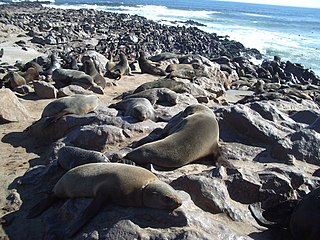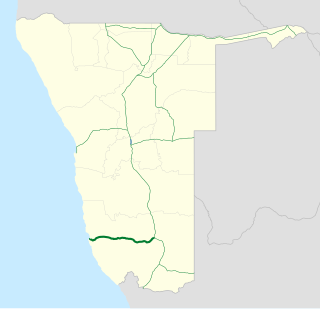Related Research Articles

The International Red Cross and Red Crescent Movement is an international humanitarian movement with approximately 97 million volunteers, members and staff worldwide, which was founded to protect human life and health, to ensure respect for all human beings, and to prevent and alleviate human suffering. Within three distinct organizations that are legally independent from each other, but are united within the movement through common basic principles, objectives, symbols, statutes and governing organisations, there are the International Committee of the Red Cross (ICRC), that is a private humanitarian institution founded in 1863 in Geneva, Switzerland, in particular by Henry Dunant and Gustave Moynier. Its 25-member committee has a unique authority under international humanitarian law to protect the life and dignity of the victims of international and internal armed conflicts. The ICRC was awarded the Nobel Peace Prize on three occasions.

Namibia, officially the Republic of Namibia, is a country in Southern Africa. Its western border is the Atlantic Ocean; it shares land borders with Zambia and Angola to the north, Botswana to the east and South Africa to the south and east. Although it does not border Zimbabwe, less than 200 metres of the Zambezi River separates the two countries. Namibia gained independence from South Africa on 21 March 1990, following the Namibian War of Independence. Its capital and largest city is Windhoek. Namibia is a member state of the United Nations (UN), the Southern African Development Community (SADC), the African Union (AU) and the Commonwealth of Nations.

The Himba are indigenous peoples with an estimated population of about 50,000 people living in northern Namibia, in the Kunene Region and on the other side of the Kunene River in southern Angola. There are also a few groups left of the OvaTwa, who are also OvaHimba, but are hunter-gatherers. However, the OvaHimba do not like to be associated with OvaTwa. Culturally distinguishable from the Herero people, the OvaHimba are a semi-nomadic, pastoralist people and speak OtjiHimba, a variety of Herero, which belongs to the Bantu family within Niger–Congo. The OvaHimba are semi-nomadic as they have base homesteads where crops are cultivated, but may have to move within the year depending on rainfall and where there is access to water.

Prohibitory traffic signs are used to prohibit certain types of manoeuvres or some types of traffic.

Keetmanshoop is a city in the ǁKaras Region of southern Namibia, lying on the Trans-Namib Railway from Windhoek to Upington in South Africa. It is named after Johann Keetman, a German industrialist and benefactor of the city.

A field hospital is a temporary hospital or mobile medical unit that takes care of casualties on-site before they can be safely transported to more permanent facilities. This term was initially used in military medicine, but it is inherited to be used in civil situations such as disasters and major incidents.
The British Red Cross Society is the United Kingdom body of the worldwide neutral and impartial humanitarian network the International Red Cross and Red Crescent Movement. The society was formed in 1870, and is a registered charity with more than 17,200 volunteers and 3,400 staff. At the heart of their work is providing help to people in crisis, both in the UK and overseas. The Red Cross is committed to helping people without discrimination, regardless of their ethnic origin, nationality, political beliefs or religion. Her Majesty The Queen is the patron of the society.

German Namibians are a community of people descended from ethnic German colonists who settled in present-day Namibia. In 1883, the German trader Adolf Lüderitz bought what would become the southern coast of Namibia from Josef Frederiks II, a chief of the local Oorlam people, and founded the city of Lüderitz. The German government, eager to gain overseas possessions, annexed the territory soon after, proclaiming it German South West Africa. Small numbers of Germans subsequently immigrated there, many coming as soldiers, traders, diamond miners, or colonial officials. In 1915, during the course of World War I, Germany lost its colonial possessions, including South West Africa ; after the war, the former German colony was administered as a South African mandate. The German settlers were allowed to remain and, until independence in 1990, German remained an official language of the territory alongside Afrikaans and English.

The International Federation of Red Cross and Red Crescent Societies (IFRC) is a worldwide humanitarian aid organization that reaches 160 million people each year through its 192 member National Societies. It acts before, during and after disasters and health emergencies to meet the needs and improve the lives of vulnerable people. It does so with impartiality as to nationality, race, gender, religious beliefs, class and political opinions.

Cape Cross is a small headland in the South Atlantic in Skeleton Coast, western Namibia, on the C34 highway some 60 kilometres north of Hentiesbaai and 120 km north of Swakopmund on the west coast of Namibia.

The Namibia University of Science and Technology (NUST), formerly known as Polytechnic of Namibia, is an institute of tertiary education in the city of Windhoek, Namibia. Andrew Niikondo is its acting vice-chancellor. NUST was headed by the founding vice-chancellor Tjama Tjivikua until March 2019. After two acting appointments, Erold Naomab was appointed vice-chancellor in January 2021. The largely ceremonial role of chancellor of the university is held by Peter Katjavivi.

The 2008 Namibia floods took place in early February 2008, a rapid onset of heavy rains triggered floods in northern Namibia, leading to one of its worst floods in 50 years. The floods had killed 42 people by early March and an estimated 65,000 people were affected, primarily in the regions of Omusati, Oshikoto, Oshana, Ohangwena and Caprivi. 40,000 people were assisted by the Namibian Red Cross with 4,600 in relocation camps. Over-crowding and insanitary conditions caused health concerns in relocation camps and an outbreak of cholera was announced in March. On 14 March, the United Nations Office for Outer Space Affairs triggered the International Charter for "Space and Major Disasters". Staple crops were devastated and 52,000 people from flood-affected areas were considered in need of immediate of assistance to cover their basic food needs. Deputy Prime Minister Libertine Amathila declared that the government would spend 65 million Namibian dollars to assist the displaced. Long-term impacts included damage to farmland, housing, schools, roads and infrastructure across the region. The floods reduced the resilience of the population who were left vulnerable to further flooding which occurred in 2009.

B4 is a national highway of Namibia. It passes through the ǁKaras Region of Namibia in the south-west in a west–east direction for 334 kilometres (208 mi), connecting Lüderitz on the coast to Keetmanshoop.

The 2009 Angola, Namibia and Zambia floods was a natural disaster which began in early March 2009 and resulted in the deaths of at least 131 people and otherwise affected around 445,000 people. The floods affected seven regions of Namibia, three provinces of Zambia, two regions of Angola and part of Botswana. The floodwaters damaged buildings and infrastructure and displaced at least 300,000 people. A state of emergency was declared in northern Namibia and there were fears that a disease epidemic would ensue. The Red Cross agencies and governments of the two countries responded to the disaster, and aid was distributed by the World Health Organization.

German South West Africa was a colony of the German Empire from 1884 until 1915, though Germany did not officially recognise its loss of this territory until the 1919 Treaty of Versailles. With a total area of 835,100 km², it was one and a half times the size of the mainland German Empire in Europe at the time. The colony had a population of around 2,600 Germans.
Dr. Helena Ndaipovanhu Ndume is a Namibian ophthalmologist, notable for her charitable work among sufferers of eye-related illnesses in Namibia. To date, Dr. Ndume has ensured that some 30,000 blind Namibians have received eye surgery and are fitted with intra-ocular lens implants free of charge. She is currently the head of the Ophthalmology department at Windhoek Central Hospital, Namibia’s largest hospital, and is one of only six Namibian ophthalmologists. She was listed as one of BBC's 100 women during 2018.
The Republic of Namibia has an honours system comprising orders, medals, military decorations, and police decorations. Legislation also provides for the establishment of decorations and medals for the intelligence service, the prisons service, and the fire services.

The Indian Red Cross Society (IRCS) is a voluntary humanitarian organization to protect human life and health based in India. It is part of the International Red Cross and Red Crescent Movement, and so shares the Fundamental Principles of the International Red Cross and Red Crescent Movement. The society's mission is providing relief in times of disasters/emergencies and promoting health & care of vulnerable people and communities. It has a network of over 700 branches throughout India. The Society uses the Red Cross as an emblem in common with other international Red Cross societies. Volunteering has been at the very heart of the Indian Red Cross Society since its inception in 1920, with the Society having Youth and Junior volunteering programmes. The Society is closely associated with the St John Ambulance in India.
The Baynes Mountains are a mountain range in Namibia.
References
- ↑ "About us". Namibia Red Cross Society. Retrieved 14 January 2021.